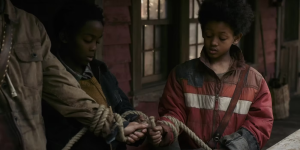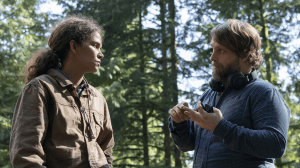In the latest supernatural thriller from French filmmaker Alexandre Aja, Never Let Go, one mother must face the stark realities and consequences of protecting her children amongst the threats of starvation, isolation and possible death. Led by Halle Berry, the film centers around a single mother called “Momma,” who lives in a deeply secluded cabin in the woods with her two young boys (Percy Daggs IV and Anthony B. Jenkins) in what seems to be a post-apocalyptic world. According to her, the family is all that is left of humanity, and a malevolent force awaits to kill them off each time they scavenge outside for food and supplies, unless they are tethered by a network of protective ropes that ward off the evil spirits. However, when their rations run dangerously low, the boys begin to question if their mom is telling the truth or if there is a functioning society beyond the edge of the trees.
Here, Director Aja talks to Deadline about the power of family, female storytelling and the secrets of making a horror film.
Alexandre Aja and Halley Berry behind the scenes of Never Let Go
Lionsgate
DEADLINE: This woodsy location is so beautiful. Can you talk more about where you shot the film?
ALEXANDRE AJA: In reading the script, I knew the story of this mom living with two kids off the grid. There’s this fourth character: the forest. I wanted the forest that was very lush and magical, but at the same time, without any life in it. I needed something that would be a pure nightmare material to create my vision. A few years ago, I made this movie with Daniel Radcliffe, Horns, and I shot in British Columbia, and we found this spectacular rainforest that we used partially. And I knew that going back there with a much darker angle will let me use that type of forest in a different way. So, we returned to Vancouver, found this absolutely outstanding forest an hour away from the city, and built a house in the middle of it. That was very important to create a real location in this forest where there’s no electricity and feels very remote and to be able to see the forest through the windows and to see inside the house from the outside to have that world tied together like the rope that is tying everyone together in the story.
DEADLINE: A lot of your horror films have women at the center. What draws you to these strong female characters in perilous situations?
AJA: Maybe it’s because I’m surrounded by really amazing women in my life who show me a lot of strengths and who are brave, courageous human beings. Also, at the end of the day, it’s a human story. When I read the script, I’m not really looking [for gender]. When I was doing Crawl, I was reading about someone going into the middle of a storm to save her dad, but I felt like I was going to go save my dad in the middle of the storm. I was really fully putting myself within that story. When I read the script for Never Let Go, I was that parent wondering what the fine line between over-protecting your kid and becoming the most dangerous thing for them is. And how you don’t infect them with your own fear by keeping them on the rope. The rope being, of course, that allegory of that bond between kids and parents.
It is always about the human character. Yet somehow, the best stories that I’ve read or worked on are always centering female protagonists. And maybe some writers are just better when they write females rather than guys [laughs]. But I got really lucky to be attached to all those great stories.
DEADLINE: Were there any particular themes you kept in mind while filming? You always have unique swivels and close-ups across your filmography, but I wondered what was different here.
AJA: I wanted to be as close as I can to those characters. What really interests me in the story is not necessarily the ride into a very scary experience but more about this question about that person living with her two kids. One believes everything she says, and the other starts questioning. I wanted to be close to them. But how do I create fear as a director? I feel that one of the rules is to break the rule. When you watch all the movies, you get used to the music of them and, the way they prepare a jumpscare, and the way they repeat some tropes again and again. So, when you start working on a story, you really have to reinvent the cinematic language to create a new way of scaring the audience and your technique and go into unexpected places. And sometimes you have to force yourself to forget about the book of tricks you know to find new ones.
DEADLINE: What are your checks and balances within yourself? How do you know, “OK, this is the take.”
AJA: It’s very simple. At some point, you’re sitting next to the camera looking at your actors, or you’re sitting behind the video village looking at the screen, and something magic happens where you forget where you are, where you forget the crew around you, where some kind of image just pops in front of your eye, and you feel it. It’s an instinct thing, and you just know you have it. There were some scenes that were very intense and dark in the movie, and until we got to that point, I was still looking and seeing the crew and how they were reacting to everything. When the sparks came to life, I was like, “Wow,” and that’s how I knew I had it.
DEADLINE: Can you talk about working with Halle Berry and the kids, Percy Daggs IV and Anthony B. Jenkins?
AJA: I remember the first time I met with Halle. She looked me in the eye and said, “I want to be sure we’re not going to compromise on the character complexity. That we’re not going to try to make her more likable upfront, we’re not going to try to erase all the contrast that I want to bring and even push further.” And it was music to my ear, it was exactly what I wanted to do. So when you share the same vision, it’s easy then to create and push and develop even more because not a lot of actors could pull that to be able to generate that feeling of, of course, they’re loving their kids more than anything in the world, and they will sacrifice everything to protect them, but in the same time expect that very kind of toxic, very scary aspects that she’s becoming through the movie.
We also knew we needed to find young actors to play along and be as strong as she is. It took us a moment to see a lot of very young and talented actors across the world, but it was only when we met with Percy, who plays Nolan, he read, and by the end of the audition we were all in tears. It was obvious that this little guy was able to be so rebellious and angry and remind me of Halle’s version of the character she wanted to bring to the screen. And a few weeks after we got Anthony, and the same magic happened, so we knew we were going to do something special.

Anthony B. Jenkins in Never Let Go
Lionsgate
DEADLINE: We never get to know how the world ended up the way that it did. On top of that, we also lose Momma in the latter half of the film. Did you and the writers Kevin Coughlin and Ryan Grassby have any conversation about adding context or keeping Halle’s character alive?
AJA: It was a very interesting reaction, and I wanted to preserve it because when I read the script, it was already there, and I was surprised the same way you were. It was an end that I didn’t see coming. So, what we did was we kept that and pushed the narrative even further. We set up a plan for the kids to escape, to give that feeling of, “Oh, it’s going to be in that classical storytelling way where they try to escape, and she’s after them,” something a little bit seen before. And so, we just created that so the surprise was even stronger. At the end of the day, the movie presents itself it’s a post-apocalyptic movie like A Quiet Place or Bird Box. The film is about the world being gone by a supernatural force that made everyone kill each other. But the more we get into the story, the more we realize it’s just about this woman who believes in an evil force that might have destroyed the world. However, the world might be out there, and the world might be completely OK. She might even be the one that’s suffering from a really strong trauma and is going through [a bout] of mental illness somehow.
DEADLINE: What was the challenge of creating a film like this?

Percy Daggs IV in Never Let Go
Lionsgate
AJA: There are always very challenging scenes, and then you get on the set in the morning and say, “OK, this is very important, and we need to have it.” And there’s all sorts of challenges when working with young actors because you can only have them for a few hours on set. So, even if you are well-prepared, you’re always on the line. But at the end of the day, if you come back home feeling that you did even better than you were expecting or not, this is where you can judge the quality of what you have. There is not a really specific moment that I felt, “Oh, I’m disappointed.” It’s more like, “Oh no, in fact, it worked.” I worked with such an amazing crew and actors. I felt every day going back that we were all working together towards the same goal. And by experience on all the movies I made, this one was a great one with everyone working with the same vision.
[This interview has been edited for length and clarity]

